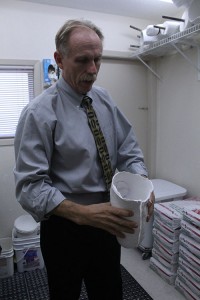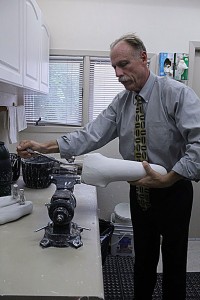By Lyndi-Colleen Morgan

Caydence Lee is photographed wearing her myoelectric arm. This arm is one of her three current ones which also includes her recreational and swimming arms. (Photos courtesy of Candyce Lee)
Five-year-old Caydence Lee plays sports and takes part in activities just like any other little girl, but with one thing that sets her apart; a prosthetic arm.
Candyce Lee was 25 weeks pregnant when she discovered her daughter Lee would be born without the lower half of her right arm. The first thought to cross her mind was worrying about the things her daughter would not be able to do.
“I spent the rest of my pregnancy worrying about the things he or she would not be able to do. I would go through every possible scenario where you would need 2 hands and I grieved for her already,” said Candyce.
An amputee is an individual who has lost one or more of their limbs, including those born as congenital amputees. According to the Canadian Disability Tax website, there are 200,000 registered amputees in Canada, with the majority using assistive and recreational devices in their daily lives.
Advancements in technology have allowed people to be able to customize their prosthesis to suit any activity to give them independence.
Anne Mclachlan, doctor of psychology, says the use of these prosthesis can improve the quality of life for an individual. Often missing a limb not only causes physical trauma to the body, but it can cause mental trauma. Receiving a prosthetic gives them the opportunity to get some aspect of their previous life back.
“Their quality of life usually improves, because there is a period of time when they are dependent on being in a wheelchair, for example,” said Mclachlan. “So then they are able to get around with the use of this prosthetic. They have more mobility.”
She also said they are able to achieve independence and be able to rely on themselves.
Each prosthesis can be specialized to complete a specific number of tasks depending on what the individual is looking for.
Brock Loewen, founder of Loewen Prosthetics Services Ltd. in Windsor said technologies and materials used to build custom prosthesis, has advanced so that prosthetics are more durable, light weight and health conscious. Whereas wood, leather and common metals were used to manufacture pieces at earlier points in time, carbon fibers, thermoplastics and other metals are used to create modern prosthesis. He also said the addition of microprocessors has changed the way individual components move on a prosthetic.
“The upper extremity prosthetics with microprocessors is one of the biggest steps in technology and prosthetic fitting,” said Loewen. “When they started to develop and perfect a hand, where the joints and the fingers articulate… they can do all these things, whereas they couldn’t do them before with older style myoelectric prosthesis.”
Government and third party groups offer assistance programs for amputees, which help cover part of the cost of their prosthetics. Prosthetics can become very expensive, and range in cost depending on complexity. Upper body prosthesis can cost between $3,000 and $30,000 while lower body prosthetics can cost from $5,000 to $50,000. The cost is split into procedure and componentry costs, which are approved by the Ontario Ministry of Health’s Assistive Devices Program.
Candyce said Lee has had eight arms over the past five years, each with its own task. As she continues to grow she will need to be fitted with new prosthetics. Currently Lee has three arms: a recreational, a swimming arm, and a myoelectric arm. The recreational device has several different attachments which screw, allowing for diversity among the arm.
Candyce said the cost of the myoelectric arm was $13,000, the swimming and recreational devices were $6,500. The attachments for the recreational device were $500 dollars a piece on average. She also said the cost of the myoelectric arm was primarily covered by the government, with the War Amps and Child Amputee Program stepping in to pay the remainder of the cost.
“Caydence not only receives help financially for her arms, War Amps does so much more. They also provide us with a constant listening ear. Any questions or concerns we have are always met with answers,” she said.
Samuel Giberson is the communications assistant for the War Amps office in Ottawa. Giberson has been working with the War Amps since August. Before working with them he was part of the organization for the past 21 years as a congenital amputee.
He also said although he doesn’t personally use a prosthetic, he has seen what they can mean to the individuals who have received them.
“The War Amp biggest role in the innovation of prosthetics is bringing awareness about prosthetics and amputation, and through that we have been able to encourage others to go out and ask questions, and ask their prosthetists what is available to them. We don’t deal directly with the innovations of the prosthetics, but we are more than happy to help give information, and encourage communication between people to discuss the topic.”
Click the photo to read more.











